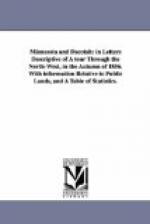“For several years I had trading-posts extending from Lake Superior to the Red River of the North, from 46 degrees to 49 degrees north latitude, and never found the snow so deep as to prevent supplies being transported from one post to another with horses. One winter, north of Crow Wing, say 47 degrees north latitude, I wintered about sixty head of horses and cattle without giving them food of any kind except such as they could procure themselves under the snow. Between the 45th and 49th degrees north latitude, the snow does not fall so deep as it does between the 40th and 45th degrees; this is easily accounted for upon the same principle that in the fall they have frosts much earlier near the 40th than they do near the 45th degree. I say this in reference to the country watered by the Mississippi River. Owing to its altitude the atmosphere is dry beyond belief, which accounts for the absence of frosts in the fall, and for the small quantity of snow that falls in a country so far north. Voyageurs traverse the territory from Lake Superior to the Missouri the entire winter with horses and sleds, having to make their own roads, and yet with heavy loads are not detained by snow. Lumbermen in great numbers winter in the pine regions of Minnesota with their teams, and I have never heard of their finding the snow too deep to prosecute their labors. I have known several winters when the snow at no time was over six inches deep.”
The Hon. H. H. Sibley, ex-delegate from Minnesota, in a letter dated at Mendota says: “As our country is for the most part composed of prairie, it is of course much exposed to the action of the winds. It is, however, a peculiarity of our climate, that calms prevail during the cold weather of the winter months; consequently, the snow does not drift to anything like the extent experienced in New England or northern New York. I have never believed that railroad communication in this territory would be seriously impeded by the depth or drift of snow, unless, perhaps, in the extreme northern portion of it.” (See Explorations and Surveys for the Pacific Railroad, I., 400.)
A few facts in regard to the people who live four or five hundred miles to the north, will best illustrate the nature of the climate and its adaptedness to agriculture.
It is common to say that settlements have not extended beyond Crow Wing. This is only technically true. There is a settlement at Pembina, where the dividing line between British America and the United States crosses the Red River of the North. It didn’t extend there from our frontier, sure enough. If it extended from anywhere it must have been from the north, or along the confines of that mystic region called Rainy Lake. Pembina is said to have about 600 inhabitants. It is situated on the Pembina River. It is an Indian-French word meaning cranberry. Men live there who were born there, and it is in fact an old settlement. It was founded by British




